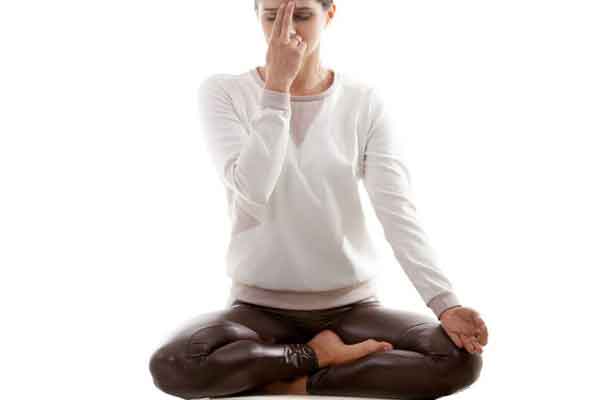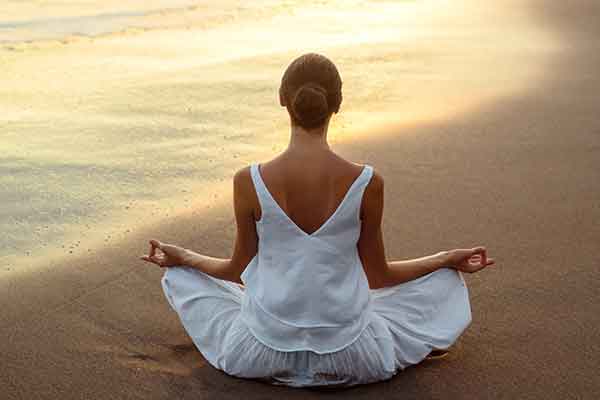Pranayama

“Pranayama is to Yoga, what the heart is to the human body.”
– B.K. Iyengar
Pranayama or breath control is an important bridge between the outward practices of yoga, like the asanas, and the inward surrendering yogic practices. It is a link between the mind and body; between the conscious and unconscious.
By focusing on the breath the mind becomes calm and balanced.
Practice of Pranayama controls the mind and slows the breath so that the higher life-force can manifest. It consists of deepening and extending the prana or life-force until it leads to a condition of peace.
MEANING
“Prana” means life force and “anayama” means control. Pranayama means mastering the life force within. When consciously controlled, it has a powerful vitalizing effect on the body, mind and spirit.
Everything we do uses life force or prana – notice how fatiguing it is when an argument leaves you feeling drained. For most of us, this vital energy is constantly depleted and never recharged. Pana is dissipated by stressful lifestyle and habits or emotional outbursts.
PURPOSE
Pranayama also helps to connect the body to its battery, the solar plexus, where tremendous potential energy is stored. When tapped through specific techniques this vital energy, or prana, is released for physical, mental and spiritual rejuvenation. Regular practice removes obstructions, which impede the flow of vital energy. When the cells work in unison, they bring back harmony and health to the system.
FAST, SHALLOW BREATHING
Pollution, bad posture and faulty living habits enable us to use only a fraction of our potential respiratory capacity. Our lifestyle and unhealthy habits cause restriction in our breathing pattern. Poor posture (hunching, slouching) reduces lung capacity. This results in fatigue caused by the decrease in blood circulation and insufficient supply of oxygen to the blood cells.
Oxygen is the most vital nutrient in our bodies. It helps sustain the flow of oxygenated blood to the nerves, brain, spinal cord and cardiac muscles, thereby maintaining their efficiency.
We need to breathe slowly and deeply. Quick, shallow breathing results in oxygen starvation, which leads to reduced vitality, premature ageing, a poor immune system and fatigue. No one can live for more than a few minutes without breathing, yet how many of us are even aware of the importance of proper breathing?
LIFE SPAN
The longevity of the body increases as the rate of breathing reduces. In the animal world, there is a strong correlation between the number of breaths and life span. For example, the giant tortoise, which takes three breaths a minute, can live about 180 years, whereas a monkey, which takes thirty breaths a minute, has a life span of about twenty to thirty years.
DID YOU KNOW?
- We take approximately 21,600 breaths every day.
- According to the ancient yogic texts, we are meant to live a full 120 years.
- Breathing and our state of mind are directly related. When we are excited, angry or stressed, the breathing becomes fast and shallow.
INTERIORIZATION
The link between mind and breath is significant. The Yogic sutras encourage practice of pranayama to calm the mind, especially before practicing meditation. The first step is to create breath awareness. Here, awareness of the breath means keeping the mind alert, still and free of clutter. This discipline allows the mind to interiorize and develop focus and concentration.
Meditation is described as “the steady continuous flow of concentration.” Pranayama, or breath awareness, is a means to get to that state.
CONCENTRATION
During the practice, the mind concentrates on inhalation, exhalation or retention of the breath. Different pranayamas emphasize different techniques.
Inhalation supplies abundance of oxygen to the entire body.
Exhalation expels waste products and toxins from the body.
Retention is holding of the breath to gain control and prevent dissipation of energy.
BENEFITS
- Pranayamas cause rhythmic expansion of the lungs, creating better circulation within the kidneys, liver, stomach, spleen, intestines, skin and other organs in the body.
- Oxygen is provided for efficient functioning of every body cell. It purifies the blood stream and therefore there is improvement in the quality of blood.
- The mind is calm and able to concentrate better. There is greater clarity of thought.
- Deep, slow breathing results in a stronger and more efficient working of the heart and lungs. This also means that correct breathing practices can lower blood pressure and reduce the likelihood of heart disease.
- The movement of the diaphragm during deep breathing exercises massages the abdominal organs and aids the digestion and elimination process.
- The skin becomes smoother and there is reduction of facial wrinkles because of better circulation and release of tension in the body and mind.
BASIC INSTRUCTIONS
- Find a quiet place where you won’t be distracted. The room should be well ventilated.
- Sit straight. Breathe slowly and deeply.
- You should do the exercises on an empty stomach. Practicing pranayama after a heavy meal reduces concentration; also, the food in your stomach causes some of your blood and oxygen supply to be diverted into the stomach for digestion.
- Breathing should be smooth, steady and continuous, performed with utmost concentration.
- Know your limits. Don’t strain your breath so that breathing becomes uncomfortable.
PRANAYAMA EXERCISES
YOGIC BREATHING (THE COMPLETE BREATH)
This breathing exercise uses the lower, mid and upper part of the respiratory muscles. Start with abdominal breathing, followed by thoracic breathing and finally clavicle breathing. Reverse the order when you exhale.
Benefits
- Increases lung capacity, slows respiration rate.
- Calms the mind.
Sheetkari (cooling breath)
Sheetkari means cooling. This technique is unusual because the inhalation is through the mouth and exhalation though the nostrils.
The tip of the tongue is placed on the palate. Inhale through the mouth and exhale through the nose.
Benefits
- Cools the system.
- Relaxes the mind.
BHRAMARI (HUMMING BEE)
Brahmari means bee. The exhalation sound is similar to a female bee.
Place the thumb on your ears; and as you inhale drop the head behind, then exhale making the sound of the humming bee and lower your chin down.
Benefits
- Nourishes and calms the brain cells.
- Soothes the nerves.
- Helps in treating insomnia
UJJAYI (OCEAN BREATH)
Ujjayi breath, also known as the “ocean breath”, the sound made during this practice resembles the distant sound of the rolling of the ocean.
Begin by sitting in a comfortable position and close your eyes. Begin by taking long, slow and deep breaths through the nostrils. Now, allow the breath to be gentle and relaxed as you contract the back of your throat, slightly, in order to breathe in and out. You need to create a steady hissing sound as you do this exercise. Lengthen the inhalation and the exhalation as much as possible without creating tension in any part of the body. Allow the sound of the breath to be smooth and continuous.
Benefits
- Strengthens the nervous system and improves concentration.
- Stimulates blood circulation and increases the body’s’ metabolism.
- Improves lung stamina.
- Relaxes the body and mind.
NADI SHODHANA (ALTERNATE NOSTRIL BREATHING)
This is a simple form of alternate nostril breathing. Nadi means, “channel” and refers to the energy pathways through which the prana flows. Shodhana means, “cleansing”. Nadi shodhana means purification of nadis or channels.
- Hold your right hand up and curl your index and middle fingers toward your palm. Close the right nostril by pressing it gently with your thumb and inhale through the left nostril. Now, close the left nostril with your thumb and exhale through the right nostril.
- Inhale through the right nostril, close it, and then exhale through the left nostril. (This is one round of Nadi Shodhana.)
- Now, inhale through the left.
- Exhale through the right.
- Inhale through the right.
- Exhale through the left.
Benefits
- Strengthens the nervous system.
- Helps conditions such as anxiety, depression, hypertension, hypotension.
KAPALABHATI (CLEANSING BREATH)
Kapala means skull and bhati means to purify. In this pranayama, through quick, rapid expulsions of the breath, the nasal passages are cleaned and purified.
Inhale deeply. Exhale partially with rapid movements of the abdomen.
Benefits
- Increases oxygen and blood circulation to the head region.
- Improves digestion, prevents constipation.
- Tones and strengthens the abdominal muscles.





